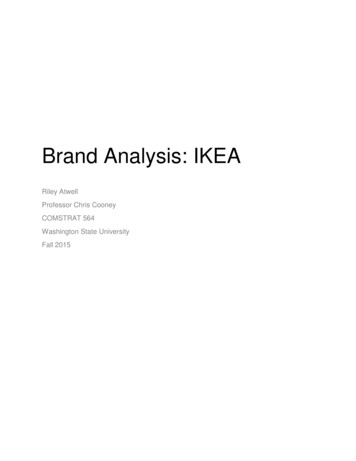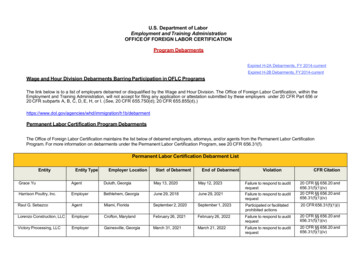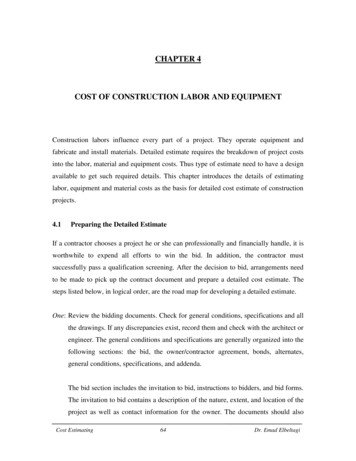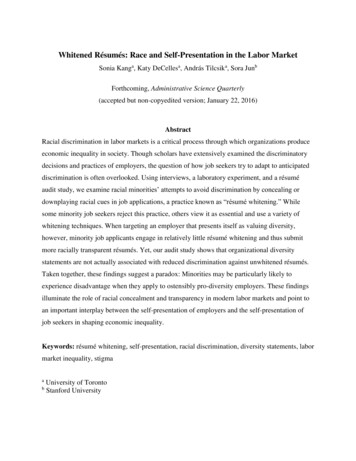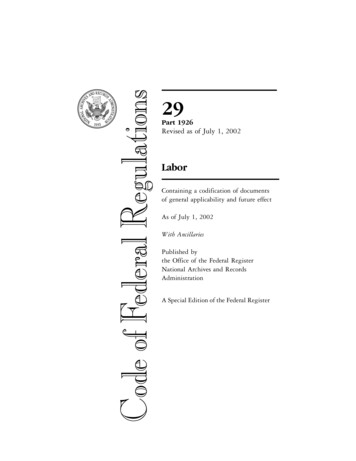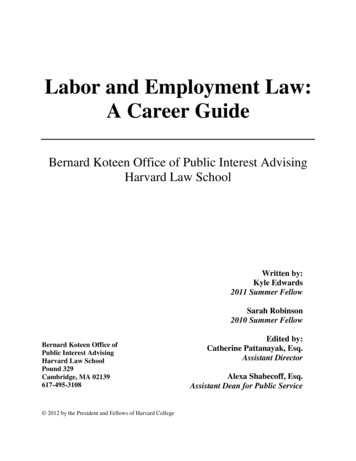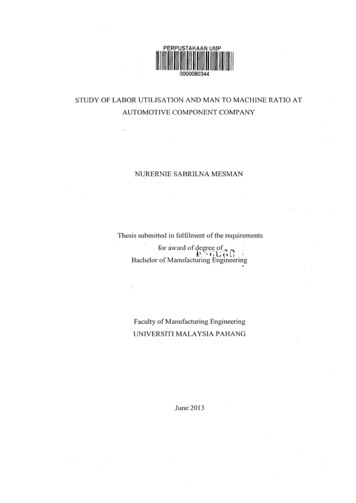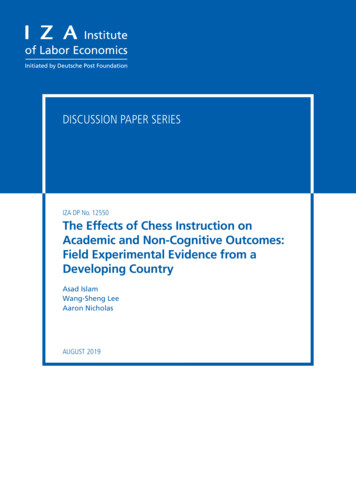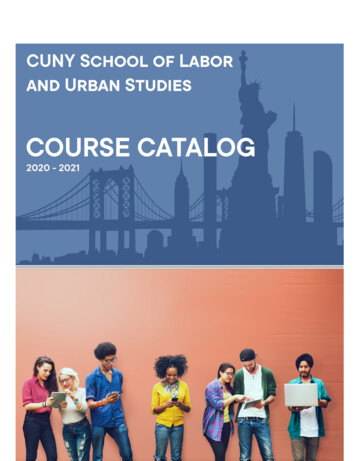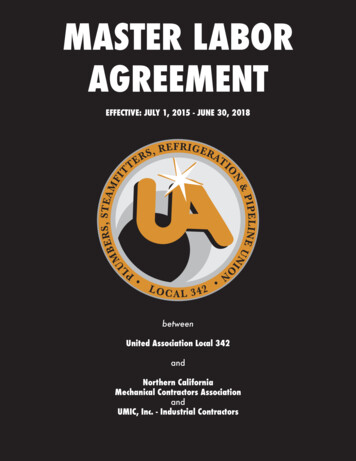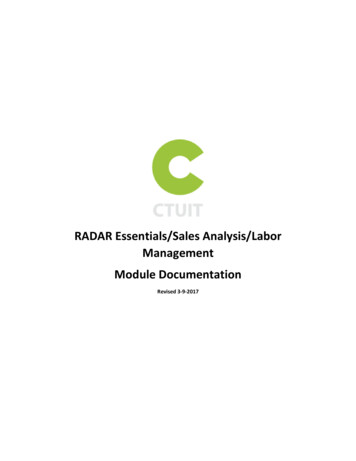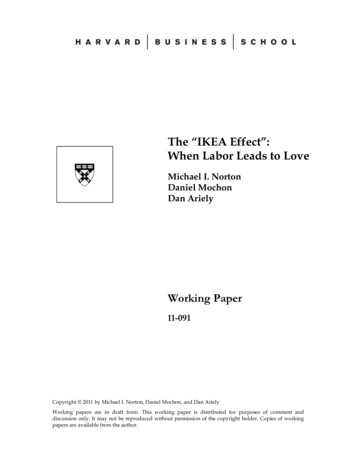
Transcription
The “IKEA Effect”:When Labor Leads to LoveMichael I. NortonDaniel MochonDan ArielyWorking Paper11-091Copyright 2011 by Michael I. Norton, Daniel Mochon, and Dan ArielyWorking papers are in draft form. This working paper is distributed for purposes of comment anddiscussion only. It may not be reproduced without permission of the copyright holder. Copies of workingpapers are available from the author.
IKEA Effect - 1 -The “IKEA Effect”: When Labor Leads to LoveMICHAEL I. NORTONDANIEL MOCHONDAN ARIELY**Michael I. Norton (mnorton@hbs.edu) is an Associate Professor of Business Administration inthe Marketing Unit at the Harvard Business School, Soldiers Field Road, Boston, MA, 02163.Daniel Mochon (dmochon@ucsd.edu) is a Post-Doctoral Fellow in Marketing at the RadySchool of Management, University of California, San Diego, Otterson Hall, 9500 Gilman Drive,MC 0553, La Jolla, CA, 92093. Dan Ariely (dandan@duke.edu) is the James B. Duke Professorof Behavioral Economics at Duke University, 1 Towerview Drive, Durham, NC, 27708. Wethank Mika Chance, Christina Huang, Amy Shelton, Lisa Shu, Carrie Sun, Stephanie Wu, andTianLun Yu for their assistance running the experiments and Lalin Anik, Ryan Buell, ZoeChance, John Gourville, Anat Keinan, Mary Carol Mazza, and Lisa Shu for their comments.
IKEA Effect - 2 AbstractIn a series of studies in which consumers assembled IKEA boxes, folded origami, and built setsof Legos, we demonstrate and investigate the boundary conditions for what we term the “IKEAeffect” – the increase in valuation of self-made products. Participants saw their amateurishcreations – of both utilitarian and hedonic products – as similar in value to the creations ofexperts, and expected others to share their opinions. Our account suggests that labor leads toincreased valuation only when labor results in successful completion of tasks; thus whenparticipants built and then destroyed their creations, or failed to complete them, the IKEA effectdissipated. Finally, we show that labor increases valuation of completed products not just forconsumers who profess an interest in “do-it-yourself” projects, but even for those who arerelatively uninterested. We discuss the implications of the IKEA effect for marketing managersand organizations more generally.
IKEA Effect - 3 The “IKEA Effect”: When Labor Leads to LoveWhen instant cake mixes were introduced in the 1950’s as part of a broader trend tosimplify the life of the American housewife by minimizing manual labor, housewives wereinitially resistant: The mixes made cooking too easy, making their labor and skill seemundervalued. As a result, manufacturers changed the recipe to require adding an egg; while thereare likely several reasons why this change led to greater subsequent adoption, infusing the taskwith labor appeared to be a crucial ingredient (Shapiro 2004). Similarly, Build-a-Bear offerspeople the “opportunity” to construct their own teddy bears, charging customers a premium evenas they foist assembly costs onto them, while farmers offer “haycations,” in which consumersmust harvest the food they eat during their stay on a farm.One view of the impact of labor on valuation suggests that asking customers to assumeproduction costs should result in reduced willingness to pay once customers subtract the value oftheir labor from the overall cost of the product; the above examples instead suggest that whenpeople imbue products with their own labor, their effort can increase their valuation. And whilesome labor is enjoyable (building a bear with one’s nephew) and some labor allows for productcustomization (making a bear with one’s alma mater’s logo) – both of which might increasevaluation – we suggest that labor alone can be sufficient to induce greater liking for the fruits ofone’s labor: Even constructing a standardized bureau, an arduous, solitary task, can lead peopleto overvalue their (often poorly constructed) creations. We call this phenomenon the “IKEAeffect”, named in honor of the Swedish manufacturer whose products typically arrive with someassembly required.In the studies presented below, we have three primary aims. First, we document andexplore the magnitude of the IKEA effect: The increased valuation that people have for self-
IKEA Effect - 4 assembled products compared to objectively similar products which they did not assemble.Second, we differentiate the IKEA effect from other effects shown to increase valuation, such asthe endowment effect. Third, we explore boundary conditions for the IKEA effect, examiningwhether completion of a project is necessary for the effect to emerge, as well as whether theIKEA effect holds only for consumers who see themselves as “do-it-yourselfers,” or for allconsumers.Labor and LoveA large body of research has pointed to the centrality of labor to people’s well-being(Blustein 2008), with the feeling of productivity serving as an important goal for many people(Hsee, Yang, and Wang 2010; Keinan and Kivetz 2011). For example, being deprived of labor –in the form of unemployment – has clear financial repercussions, but also lasting psychologicalconsequences; even when people obtain future employment, the adverse impact of job loss onwell-being remains (Clark and Oswald 1994; Feather 1990; Lucas et al. 2004).But this link between labor and well-being does not explain why people might come toovervalue the things on which they have labored. One hint as to this relationship comes fromresearch which demonstrates that, although people rate their jobs as among their least pleasurableactivities, they also rate them as among their most rewarding (White and Dolan 2009). Thisironic link – between the arduous, unpleasant nature of tasks and their simultaneously rewardingproperties – has received extensive attention by researchers exploring “effort justification.” Thisresearch has demonstrated that the more effort people put into some pursuit, the more they cometo value it (Festinger 1957), in domains as varied as psychotherapy (Axsom 1989; Axsom andCooper 1985) to brainwashing (Schein 1956) to becoming a nicer person (Labroo and Kim2009). The link exists for non-humans as well, with rats and starlings preferring sources of food
IKEA Effect - 5 which require effort to obtain (Aiken 1957; Kacelnik and Marsh 2002; Lawrence and Festinger1962). Labor leading to value thus appears to be a very basic process, and an effort justificationaccount predicts that effort and valuation increase in lockstep.We suggest, however, that the psychological process by which labor leads to loverequires consideration of an additional crucial factor: The extent to which one’s labor issuccessful. Indeed, in Aronson and Mills’ (1959) classic experiment on effort justification – inwhich women were forced to undergo either no initiation, a mild initiation, or a severe initiation(reading aloud provocative words) before joining a discussion group – all participants wereallowed to successfully join the group, such that the study compared how much those who hadundergone different levels of effort subsequently liked the group they had been allowed to join.Thus the factor that we suggest is crucial for the emergence of the IKEA effect – successfulcompletion of labor – is not varied in this classic experiment, nor in the subsequent experimentsaddressing limitations of this original experiment (e.g., Gerard and Mathewson 1966).We base our prediction that the success of one’s labor is crucial for the IKEA effect toemerge on a large body of literature which demonstrates a fundamental human need foreffectance – an ability to successfully produce desired outcomes in one’s environment – and onemeans by which people accomplish this goal is by affecting and controlling objects andpossessions (Belk 1988; Dittmar 1992; Furby 1991). Indeed, in his seminal research on selfefficacy, Bandura (1977) specifically pointed to successful completion of tasks as one means bywhich people can meet their goal to feel competent and in control (see also White 1959). Just ascompleting tasks has a positive psychological impact, failure to complete tasks hascorresponding negative psychological consequences: People ruminate more on tasks that they
IKEA Effect - 6 failed to complete than on those that they successfully completed, leading to negative affect andregret (Savitsky, Medvec, and Gilovich 1997; Zeigarnik 1935).Thus our account suggests that only when people successfully complete a labor-intensivetask do they come to value the fruits of that labor – the products they have created. Wemanipulate the success of labor in several ways to test our model – of theoretical interest to ourunderstanding of the link between effort and liking, but also of practical interest to marketersconsidering engaging consumers in co-production – exploring when and why labor leads to love.Overview of the ExperimentsIn the studies that follow, we demonstrate the IKEA effect by encouraging consumers toexert effort in the production of three different products: building IKEA boxes, folding origami,and constructing sets of Legos. Experiment 1A demonstrates the basic effect, showing thatparticipants who assemble utilitarian products value them more highly than identical preassembled products. In Experiment 1B, we replicate this effect with more hedonic products, andcompare participants’ estimates of the value of their origami creations to other’s estimates oftheir value, to benchmark the increased value consumers lend to their self-made creations. InExperiment 2, we differentiate the IKEA effect from other phenomena known to increasevaluation of products, including the endowment effect and the impact of mere touch onvaluation. In both Experiments 2 and 3, we show that unsuccessful labor – either by assemblingand then disassembling a product, or failing to complete the assembly process – does notincrease valuation. Finally, Experiment 3 demonstrates that value from assembling productsoneself accrues equally to both consumers who profess to be “do-it-yourselfers” and those who
IKEA Effect - 7 do not, suggesting that the link between successful labor and valuation occurs regardless of one’sintrinsic inclination to engage in labor.Experiment 1AIn this first experiment, we establish the IKEA effect – consumers’ increased valuationfor goods they have assembled when compared to objectively similar goods not produced by theself – by comparing participants’ willingness-to-pay and liking for utilitarian products they hadassembled themselves to identical pre-assembled products.We used a standardized, utilitarian product in Experiment 1A – IKEA boxes – in order todifferentiate our findings from two related literatures. First, firms’ increasing tendency to allowconsumers to customize their products, particularly through internet channels (Gilmore and Pine1997; Pine 1993; Wind and Mahajan 1997), is effective in part because consumers are willing topay a premium for products that they have customized to their idiosyncratic preferences (Frankeand Piller 2004; Schreier 2006); with standardized IKEA boxes, however, no opportunity forcustomization exists, suggesting that any increase in valuation due to labor we observe is likelynot due to customization. Second, some research suggests that consumers value their selfdesigned products more than those designed by others over and above the value derived frommatching their preferences (Franke, Schreier, and Kaiser 2010); these studies, however, useproducts that are hedonic and intended for public display such as t-shirts, wristwatches, and cellphone covers – such that the value likely derives in part from the opportunity to show off one’sproducts to others. We use mundane, utilitarian products that are intended for privateconsumption to demonstrate that labor can lead to valuation even in the absence of additionalsources of value.
IKEA Effect - 8 MethodParticipants (N 52; 20 male, Mage 19.9, SD 1.4) at a university in the southeasternUnited States were paid 5 to participate in the experiment. We randomly assigned someparticipants – our builders – to assemble a plain black IKEA ‘Kassett’ storage box. Theseparticipants were given an unassembled box with the assembly instructions included with theproduct. Other participants – our non-builders – were given a fully assembled box and weregiven the opportunity to inspect it.After the initial stage – either building or inspecting the box – we solicited participants’reservation price by asking them to make a bid on the box. We told them that at the end of theexperiment, we would draw a random price (from an unknown distribution); if their WTP wasequal to or above that price, they would pay us that amount and take the box, while if their bidwas below the price, they would not purchase the box. This technique, a variant of the BeckerDeGroot-Marschak (1964) procedure, is an incentive compatible value elicitation method. Afterstating their willingness to pay, participants rated how much they liked the box on a 7-point scale(1: not at all to 7: very much), and the extent to which they thought the product was hedonic orutilitarian on a 9-point scale (1: completely utilitarian to 9: completely hedonic; see Dhar andWertenbroch 2000).Results and DiscussionAs we expected, participants saw the IKEA boxes as more utilitarian than hedonic, ratingthem (M 3.13, SD 1.83) significantly lower than the midpoint of the scale, t(51) 7.36, p .001.We found that builders bid significantly more for their boxes (M 0.78, SD 0.63) thannon-builders (M 0.48, SD 0.40), t(50) 2.12, p .05. Thus, while both groups were given
IKEA Effect - 9 the chance to buy the same product, those who assembled their own box valued it more thanthose who were given the chance to buy an identical pre-assembled box. We observed similareffects for subjective ratings of liking for the IKEA box, with builders reporting greater liking (M 3.81, SD 1.56) than non-bu
initially resistant: The mixes made cooking too easy, making their labor and skill seem undervalued. As a result, manufacturers changed the recipe to require adding an egg; while there are likely several reasons why this change led to greater subsequent adoption, infusing the task with labor appeared to be a crucial ingredient (Shapiro 2004). Similarly, Build-a-Bear offers people the .
